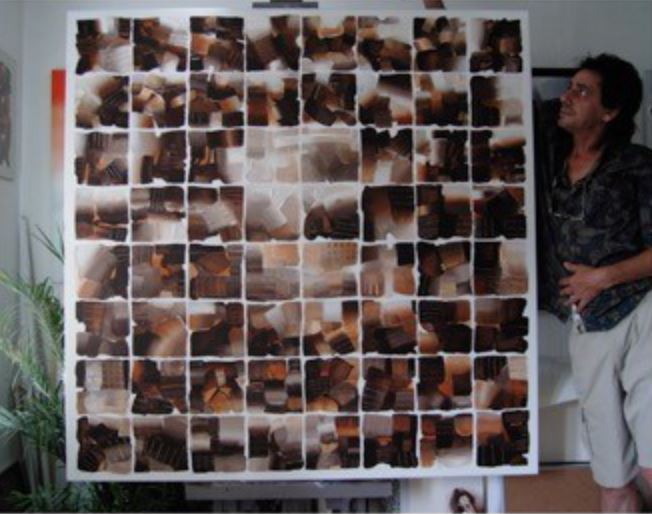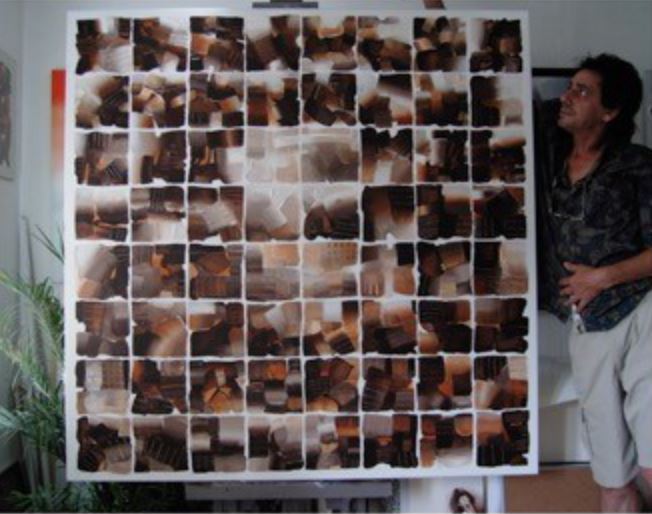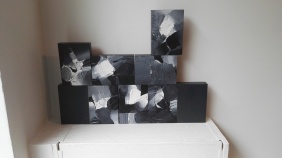Exhibition I.M. Ziad Haider- زياد حيدر

IM Ziad Haider
Gallery Out in the Field
Warmondstraat 197, Amsterdam
27/5- 27/6/2018
http://www.art-gallery-outinthefied.com
زياد حيدر
Here the Original Dutch version
The abstract works of Ziad Haider (1954, Al-Amara, Iraq-2006 Amsterdam, the Netherlands) can be interpreted as deep reflections on his own turbulent biography, but always indirect, on a highly sublimized level. Born in Iraq and lived through a period of war and imprisonment, and after he found his destiny in the Netherlands, he left an impressive oeuvre.
Ziad Haider studied in the first half of the seventies at the Baghdad Institute of Fine Arts. In the two decades before a flourishing local and original Iraqi art scene was created. From the fifties till the seventies Iraq was one of the leading countries in the Arab world in the field of modern art and culture. Artists like Jewad Selim, Shakir Hassan al-Said and Mahmud Sabri shaped their own version of international modernism. Although these artists were educated abroad (mainly in Europe), after returned to Iraq they founded an art movement which was both rooted in the local traditions of Iraq as fully connected with the international developments in modernist art. They created a strong and steady basis for an Iraqi modern art, unless how much the Iraqi modern art movement would suffer from during the following decades of oppression, war and occupation, so much that it mainly would find its destiny in exile.
The turning-point came during the time Ziad Haider was studying at the academy. Artists who were a member of the ruling Ba’th party- or willing to become one- were promised an even international career with many possibilities to exhibit, as long as they were willing to express their loyalty to the regime, or even sometimes participate in propaganda-projects, like monuments, or portraits and statues of Saddam Husayn. Ziad Haider, who never joined the Ba’th party, was sent into the army.
In 1980 the Iraqi regime launched the long and destructive war with Iran. Many young Iraqis were sent into the army to fight at the frontline. This also happened to Ziad Haider. The Iraq/Iran war was a destructive trench war in which finally one million Iraqis (and also one million Iranians) died. The years of war meant a long interruption in Ziad Haider’s career and live as an artist. It turned out much more dramatic for him, when he was back in Baghdad for a short period at home. He was arrested after he peed on a portrait of Saddam Husayn. Ziad Haider was sent to Abu Ghraib Prison, where he stayed for five years (1986-1990) probably the darkest period of his life. After his time in prison he was sent away to the front again, this time in a new war: the occupation of Kuwait and the following American attack on Iraq.


After the Intifada of 1991, the massive uprising against the Iraqi regime in the aftermath of the Gulf War, which was violently supressed, Ziad Haider fled Iraq, like many others. After a period of five years in Syria and Jordan he was recognized by the UN as a refugee and was invited to live in the Netherlands, which became his new homeland. With a few paintings and drawings, he arrived 1997 in Amersfoort. After Amersfoort he lived for short a while in Almere and finally in Amsterdam. In first instance it was not simple to start all over again as an artist in his new country. Beside he worked further in his personal style he started to draw portraits in the streets of Amsterdam (the Leidse Plein and the Rembrandtplein). Later he organised, together with the Dutch artist Paula Vermeulen he met during this time and became his partner, several courses in drawing and painting in their common studio. Ziad Haider was very productive in this period and created many different works in different styles. Giving courses in figurative drawing and painting and drawing portraits was for him very important. As he told in a Dutch television documentary on five Iraqi artists in the Netherlands (2004, see here) these activities and the positive interaction with people were for him the best tools to “drive away his nightmares”.

In his abstract works, always the main part of his artistic production, he sought the confrontation with the demons from the past. Although abstract there are often some recognisable elements, which are returning in several works during the years. A returning motive is the representation of his feet. This refers to several events from his own life. As a soldier Ziad had to march for days. When he was released from prison, together with some other prisoners, he was the only one who, although heavily tortured on his feet, who was able to stand up and walk. And his feet brought him further, on his long journey into exile, till he finally found a safe place to live and work.

The motive of his bare feet is not the only figurative element in his work. In many of his paintings and drawings there are some more or less anthropomorphic elements, often molten together with structures with the appearance of liquid metal. The theme of man and machine plays an important role in the expressive works of Ziad. Of course this is close connected to his own biography and history of war and imprisonment.
In some of his works one can vividly experience a sense of a claustrophobic space, referring to his time spending in the trenches during the war, the interior of the tank and- later- the prison-cell. But all these experiences went through a process of transformation, of abstraction and translated in the language of art. And this art is, unless the underlying struggle, very lyrical in its expression.

The also in the Netherlands living Iraqi journalist, poet and critic Karim al-Najar wrote about Ziad Haider: “For a very long time the artist, Ziad Haider, has been living in solitude, prison and rebellion. On this basis, the foregoing works constitute his open protest against the decline, triviality and prominence of half-witted personalities as well as their accession of the authority of art and culture in Iraq for more than two decades. Here we could touch the fruits of the artist’s liberty and its reflection on his works. For Ziad Haider has been able to achieve works showing his artistic talent and high professionalism within a relatively short time. We see him at the present time liberated from his dark, heavy nightmares rapidly into their embodiment through colour and musical symmetry with the different situations. It indeed counts as a visual and aesthetic view of the drama of life as well as man’s permanent question, away from directness, conventionality and false slogans”.
Although he opposed another American war against Iraq, with an uncertain outcome for its people, the end of the Ba’athist regime made it possible to visit his home country after many years of exile. In the autumn of 2003 he visited Iraq for the first time since his long absence in exile. His visit to iraq made a great impression and also influenced his work after. In the last series of paintings he made his use of colours changed dramatically. The explosive use of intense shades of red were replaced for a use of sober browns and greys. The dynamic compositions were changed in regular constructed forms. Also these works, from his last series, are represented on this exhibition.
Ziad meant a lot for many, as an artist, but also as a human being and a friend. Within the community of exiled Iraqi artists in the Netherlands he played a very important role. In 2004 he initiated the Iraqi cultural manifestation in Amsterdam, with the title “I cross the Arch of Darkness”, a quote from a poem by his friend, the also in the Netherlands living Iraqi poet Salah Hassan ( ﺃﻋﺒﺭﻗﻮﺲ ﻟﻟﻆﻻﻢ ﺃﻮﻤﻰﻋ ﻟﻟﻧﻬﺎﺭ ﺑﻌﻛﺎﺰﻱ , from his collected poems, published under the title “A rebel with a broken compass”, 1997). In this festival visual artists, poets, musicians and actors came together to show the variety and richness of the Iraqi cultual life in exile to a Dutch audience.
During the years Ziad and Paula lived at the Rozengracht in the old centre of Amsterdam, there home was a regular meetingpoint of many exiled Iraqi artists, poets, writers, musicians, actors, journalists and intellectuals. Many will cherish their sweet memories of the sometimes notorious gatherings till deep in the night. His sudden death in 2006 was a great loss for many of us.
The works of Ziad are still here and they deserve to be exhibited (now his second exhibition after he passed away). With this exhibition we celebrate Ziad Haider what he meant as an artist and as a human being.
Floris Schreve
Amsterdam, 2018
On this blog (mainly in Dutch):
Tentoonstelling Ziad Haider (Diversity and Art)
Iraakse kunstenaars in ballingschap
Modern and contemporary art of the Middle East and North Africa (English)
See also this In Memoriam of Ziad’s friend, the artcritic Amer Fatuhi
The opening:

Tentoonstelling IM Ziad Haider- زياد حيدر

IM Ziad Haider
Gallery Out in the Field
Warmondstraat 197, Amsterdam
27/5- 27/6/2018
http://www.art-gallery-outinthefied.com
زياد حيدر
Here the English version
Het abstracte werk van Ziad Haider (al-Amara, Irak, 1954-Amsterdam 2006) kan worden gezien als een diep doorleefde reflectie op zijn roerige levensgeschiedenis, zij het altijd in gesublimeerde vorm. Afkomstig uit Irak en, na een periode van oorlog en gevangenschap, uitgeweken naar Nederland, heeft hij, in de jaren dat hij werkzaam in Nederlandse ballingschap was, een groot aantal indrukwekkende werken nagelaten.
Ziad Haider studeerde begin jaren zeventig aan de kunstacademie in Bagdad.
In de twee decennia daarvoor was er in Irak een bloeiende modernistische kunstscene ontstaan. Vanaf de jaren vijftig tot in de jaren zeventig was Irak een van de meest toonaangevende landen op het gebied van moderne kunst en cultuur in de Arabische wereld. Iraakse kunstenaars als Jewad Selim, Shakir Hassan al-Said en Mahmud Sabri creëerden hun eigen versie van het internationale modernisme. Hoewel deze kunstenaars elders (vooral in Europa) waren opgeleid, trachtten zij, teruggekeerd naar hun geboorteland, een moderne kunstscene op te zetten, die zowel geworteld was in de lokale traditie, als aansloot bij de internationale ontwikkelingen. Zij creëerden hiermee een stevige basis voor een heel eigen Iraakse moderne kunsttraditie, hoezeer deze ook onder druk kwam te staan in de daaropvolgende decennia, vol met onderdrukking, oorlog en bezetting, waardoor vele Iraakse kunstenaars noodgedwongen hun werk in ballingschap moesten voortzetten.
In de tijd dat Ziad Haider studeerde kwam net het kantelpunt. Kunstenaars die lid van de regerende Ba’thpartij waren, konden, wanneer zij ook bereid waren om bij gelegenheid mee te werken met de verheerlijking van het regime en de officiële propaganda, soms een glanzende carrière tegemoetzien, tot en met de mogelijkheid tot exposeren in het buitenland. Ziad Haider, die geen lid van de Ba’thpartij was, werd na zijn studietijd meteen het leger ingestuurd.
Kort daarna, begin 1980, stortte het Iraakse regime zich in de oorlog met Iran. Vele jonge Iraki’s werden de oorlog ingestuurd om aan het front als soldaat te dienen en ook Ziad Haider trof dit lot. De Irak/Iran oorlog was een vernietigende loopgravenoorlog, waarin uiteindelijk een miljoen Iraki’s (en een miljoen Iraniërs) de dood vonden. De jaren van oorlog betekenden een lange onderbreking van Ziads loopbaan als kunstenaar. Zijn leven zou nog een veel heviger wending nemen toen hij midden jaren tachtig, gedurende een kort verlof in Bagdad, werd gearresteerd, omdat iemand over hem had geklikt bij de geheime dienst. Hij had over een portret van Saddam geplast. Voor bijna vijf jaar verbleef Ziad Haider in de beruchte Abu Ghraib gevangenis, de donkerste periode van zijn leven (1986-1990). Nadat hij was vrijgelaten werd hij weer terug het leger ingestuurd dat net Koeweit was binnengevallen. Ook de Golfoorlog van 1991 maakte hij volledig mee.


Na de volksopstand tegen het regime van 1991 ontvluchtte hij Irak. Voor vijf jaar verbleef hij achtereenvolgens in Syrië en Jordanië, totdat hij in 1997 als vluchteling aan Nederland werd toegewezen. Met een paar schilderijen en een serie tekeningen, kwam hij aan in ons land, waar hij terecht kwam in Amersfoort. Na Amersfoort woonde hij voor korte tijd in Almere en vervolgens in Amsterdam. Net als voor veel van zijn lotgenoten, was het in eerste instantie niet makkelijk om zich hier als kunstenaar te vestigen. Naast dat hij doorwerkte aan zijn persoonlijke stijl, werkte hij ook veel als portrettist en tekende hij portretten van passanten op het Leidse Plein en het Rembrandtplein. Later gaf hij, samen met Paula Vermeulen, die hij in die tijd ontmoette, ook verschillende teken- en schildercursussen in hun gemeenschappelijke atelier. Ziad Haider was in deze periode zeer productief, werkte met verschillende technieken in verschillende stijlen. Juist het werken met zijn cursisten of het tekenen van portretten op straat waren voor hem een belangrijke bron levenslust, zoals hij dat een keer verklaarde voor de IKON televisie, in een documentaire uit 2003: “Een manier om de terugkerende nachtmerries te verdrijven” (Factor, Ikon, 17-6-2003, zie hier).

In zijn abstracte werk ging Ziad Haider juist de confrontatie aan met de heftige gebeurtenissen uit zijn leven van de jaren daarvoor. In deze werken duiken ook een paar herkenbare elementen op, die regelmatig terugkeren in verschillende werken. Een motief dat op verschillende manieren terugkeert, is de weergave van zijn voeten. Dit gegeven refereert aan verschillende gebeurtenissen in zijn leven. Als soldaat moest Ziad Haider vaak lange marsen afleggen. Toen hij uit de gevangenis werd vrijgelaten was hij de enige van zijn medegevangenen die nog amper in staat was om op zijn voeten te staan. En natuurlijk hebben zijn voeten hem verder gedragen, op zijn lange reis in ballingschap, totdat hij uiteindelijk een veilige plaats vond.

Het motief van de voeten is niet het enige herkenbare gegeven in Ziads werken. Vaak zijn er min of meer antropomorfe elementen te ontdekken. Deze lijken vaak versmolten met vormen die doen denken aan gloeiend metaal. Het thema mens en machine speelt in het werk van Ziad een belangrijke rol. Ook dit thema hangt vanzelfsprekend nauw samen met zijn eigen geschiedenis van oorlog en gevangenschap.
Voelbaar is in sommige werken ook de claustrofobische ruimte, die refereert aan zijn verblijf in de loopgraven, de tank en daarna de cel, al zijn deze ervaringen altijd door een transformatieproces gegaan, waardoor ze zijn te vervatten in kunst. En deze kunst heeft, ondanks de strijd, vaak een buitengewoon lyrisch karakter.

De in Nederland wonende Iraakse journalist, dichter en criticus Karim al-Najar over Ziad Haider: ‘For a very long time the artist, Ziad Haider, has been living in solitude, prison and rebellion. On this basis, the foregoing works constitute his open protest against the decline, triviality and prominence of half-witted personalities as well as their accession of the authority of art and culture in Iraq for more than two decades. Here we could touch the fruits of the artist’s liberty and its reflection on his works. For Ziad Haider has been able to achieve works showing his artistic talent and high professionalism within a relatively short time. We see him at the present time liberated from his dark, heavy nightmares rapidly into their embodiment through colour and musical symmetry with the different situations. It indeed counts as a visual and aesthetic view of the drama of life as well as man’s permanent question, away from directness, conventionality and false slogans’.
Hoe zeer hij ook zijn bedenkingen had bij de Amerikaanse invasie van Irak in 2003, het betekende voor Ziad wel een mogelijkheid om weer zijn geboorteland te bezoeken. In de herfst van 2003 zette hij deze stap. Zijn bezoek aan Irak maakte grote indruk en had ook zijn weerslag op de laatste serie werken die hij maakte. Allereerst veranderde zijn palet. Het intense rood, dat zijn werken voor die tijd sterk had gedomineerd, werd vervangen door sobere bruinen en grijzen. De heftige bewegingen in zijn composities maakten plaats voor een regelmatiger opbouw. Ook dat werk, uit zijn laatste reeks, is op deze tentoonstelling te zien.
Ziad heeft veel betekend als kunstenaar, maar verder was hij ook een belangrijk figuur binnen de Iraakse kunstscene in ballingschap. Zo was hij de initiatiefnemer van het de manifestatie “Ik stap over de Boog van Duisternis; Iraakse kunstenaars in Amsterdam”. Onder deze titel , die verwijst naar een zin uit een gedicht van de dichter en Ziads vriend Salah Hassan, ( “ﺃﻋﺒﺭﻗﻮﺲ ﻟﻟﻆﻻﻢ ﺃﻮﻤﻰﻋ ﻟﻟﻧﻬﺎﺭ ﺑﻌﻛﺎﺰﻱ ” , uit de bundel Een rebel met een kapot kompas, 1997), werd er in 2004 een Iraaks cultureel festival in Amsterdam georganiseerd, waarin verschillende uit Irak afkomstige beeldende kunstenaars, dichters, musici en acteurs centraal stonden.
Gedurende de jaren dat Ziad en Paula samen aan de Rozengracht woonden, was hun huis een trefpunt van vele Iraakse beeldende kunstenaars, maar ook dichters, schrijvers, musici, acteurs en journalisten. Velen zullen dierbare herinneringen koesteren aan deze roemruchte avonden. Het plotselinge overlijden van Ziad Haider in 2006 kwam dan ook als een grote klap.
Zijn werk is er gelukkig nog en verdient het om getoond te worden. Met deze tentoonstelling vieren wij wat hij als kunstenaar en als mens heeft betekend.
Floris Schreve
Amsterdam, mei 2018
Verder op dit blog:
Tentoonstelling Ziad Haider (Diversity and Art)
Iraakse kunstenaars in ballingschap
Zie ook deze In Memoriam van de Iraakse kunstcriticus Amer Fatuhi
De opening:





















![36034246_10213517577988236_7883300927212355584_n[1] 36034246_10213517577988236_7883300927212355584_n[1]](https://fhs1973.files.wordpress.com/2018/05/36034246_10213517577988236_7883300927212355584_n1.jpg?w=500&resize=500%2C374&h=374#038;h=374)
![34985037_10213517563587876_4889890446261616640_n[1] 34985037_10213517563587876_4889890446261616640_n[1]](https://fhs1973.files.wordpress.com/2018/05/34985037_10213517563587876_4889890446261616640_n1.jpg?w=212&resize=212%2C212&h=212#038;h=212&crop=1)
![35296703_10213517575188166_2129127241244737536_n[1] 35296703_10213517575188166_2129127241244737536_n[1]](https://fhs1973.files.wordpress.com/2018/05/35296703_10213517575188166_2129127241244737536_n1.jpg?w=212&resize=212%2C158&h=158#038;h=158)
![36063456_10213517567267968_6463181574316752896_n[1] 36063456_10213517567267968_6463181574316752896_n[1]](https://fhs1973.files.wordpress.com/2018/05/36063456_10213517567267968_6463181574316752896_n1.jpg?w=258&resize=258%2C192&h=192#038;h=192)
![36003022_10213517567747980_8017425063580008448_n[1] 36003022_10213517567747980_8017425063580008448_n[1]](https://fhs1973.files.wordpress.com/2018/05/36003022_10213517567747980_8017425063580008448_n1.jpg?w=258&resize=258%2C258&h=258#038;h=258&crop=1)
![36199930_10213517564347895_1129103892315897856_n[1] 36199930_10213517564347895_1129103892315897856_n[1]](https://fhs1973.files.wordpress.com/2018/05/36199930_10213517564347895_1129103892315897856_n1.jpg?w=454&resize=454%2C454&h=454#038;h=454&crop=1)
![36045967_10213517568307994_5524205344345030656_n[1] 36045967_10213517568307994_5524205344345030656_n[1]](https://fhs1973.files.wordpress.com/2018/05/36045967_10213517568307994_5524205344345030656_n1.jpg?w=408&resize=408%2C304&h=304#038;h=304)
![35296464_10213517560987811_7090941600687194112_n[1] 35296464_10213517560987811_7090941600687194112_n[1]](https://fhs1973.files.wordpress.com/2018/05/35296464_10213517560987811_7090941600687194112_n1.jpg?w=304&resize=304%2C304&h=304#038;h=304&crop=1)
![36258444_10213517572868108_1868273721077137408_n[1] 36258444_10213517572868108_1868273721077137408_n[1]](https://fhs1973.files.wordpress.com/2018/05/36258444_10213517572868108_1868273721077137408_n1.jpg?w=186&resize=186%2C251&h=251#038;h=251)
![36002977_10213517573468123_8660155387439218688_n[1] 36002977_10213517573468123_8660155387439218688_n[1]](https://fhs1973.files.wordpress.com/2018/05/36002977_10213517573468123_8660155387439218688_n1.jpg?w=336&resize=336%2C251&h=251#038;h=251)
![36176164_10213517574668153_5295042206011228160_n[1] 36176164_10213517574668153_5295042206011228160_n[1]](https://fhs1973.files.wordpress.com/2018/05/36176164_10213517574668153_5295042206011228160_n1.jpg?w=186&resize=186%2C251&h=251#038;h=251)


















![36002977_10213517573468123_8660155387439218688_n[1] 36002977_10213517573468123_8660155387439218688_n[1]](https://fhs1973.files.wordpress.com/2018/05/36002977_10213517573468123_8660155387439218688_n1.jpg?w=500&resize=500%2C374&h=374#038;h=374)
![36003022_10213517567747980_8017425063580008448_n[1] 36003022_10213517567747980_8017425063580008448_n[1]](https://fhs1973.files.wordpress.com/2018/05/36003022_10213517567747980_8017425063580008448_n1.jpg?w=212&resize=212%2C212&h=212#038;h=212&crop=1)
![36034246_10213517577988236_7883300927212355584_n[1] 36034246_10213517577988236_7883300927212355584_n[1]](https://fhs1973.files.wordpress.com/2018/05/36034246_10213517577988236_7883300927212355584_n1.jpg?w=212&resize=212%2C158&h=158#038;h=158)
![36199930_10213517564347895_1129103892315897856_n[1] 36199930_10213517564347895_1129103892315897856_n[1]](https://fhs1973.files.wordpress.com/2018/05/36199930_10213517564347895_1129103892315897856_n1.jpg?w=202&resize=202%2C202&h=202#038;h=202&crop=1)
![36176164_10213517574668153_5295042206011228160_n[1] 36176164_10213517574668153_5295042206011228160_n[1]](https://fhs1973.files.wordpress.com/2018/05/36176164_10213517574668153_5295042206011228160_n1.jpg?w=150&resize=150%2C202&h=202#038;h=202)
![36258444_10213517572868108_1868273721077137408_n[1] 36258444_10213517572868108_1868273721077137408_n[1]](https://fhs1973.files.wordpress.com/2018/05/36258444_10213517572868108_1868273721077137408_n1.jpg?w=150&resize=150%2C202&h=202#038;h=202)
![34985037_10213517563587876_4889890446261616640_n[1] 34985037_10213517563587876_4889890446261616640_n[1]](https://fhs1973.files.wordpress.com/2018/05/34985037_10213517563587876_4889890446261616640_n1.jpg?w=202&resize=202%2C202&h=202#038;h=202&crop=1)
![36045967_10213517568307994_5524205344345030656_n[1] 36045967_10213517568307994_5524205344345030656_n[1]](https://fhs1973.files.wordpress.com/2018/05/36045967_10213517568307994_5524205344345030656_n1.jpg?w=236&resize=236%2C176&h=176#038;h=176)
![36063456_10213517567267968_6463181574316752896_n[1] 36063456_10213517567267968_6463181574316752896_n[1]](https://fhs1973.files.wordpress.com/2018/05/36063456_10213517567267968_6463181574316752896_n1.jpg?w=236&resize=236%2C176&h=176#038;h=176)
![35296703_10213517575188166_2129127241244737536_n[1] 35296703_10213517575188166_2129127241244737536_n[1]](https://fhs1973.files.wordpress.com/2018/05/35296703_10213517575188166_2129127241244737536_n1.jpg?w=476&resize=476%2C356&h=356#038;h=356)
![35296464_10213517560987811_7090941600687194112_n[1] 35296464_10213517560987811_7090941600687194112_n[1]](https://fhs1973.files.wordpress.com/2018/05/35296464_10213517560987811_7090941600687194112_n1.jpg?w=716&resize=716%2C716&h=716#038;h=716&crop=1)
leave a comment